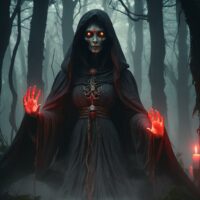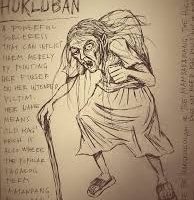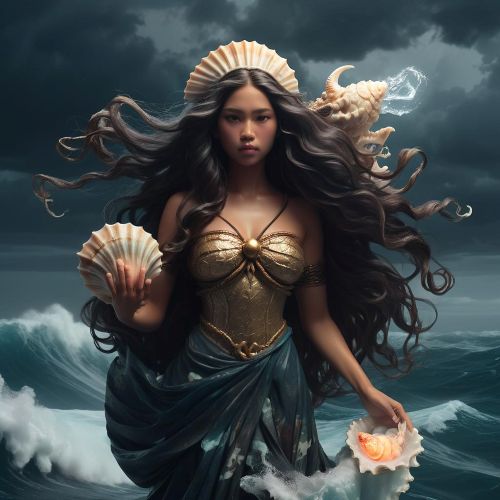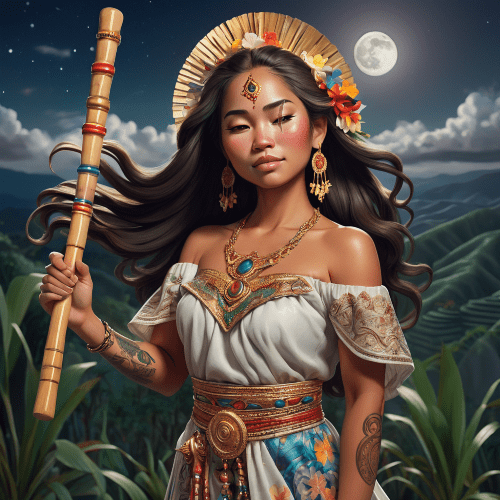Hukluban : Goddess of Death
Listen
At a glance
| Description | |
|---|---|
| Origin | Philippine Mythology |
| Classification | Gods |
| Family Members | N/A |
| Region | Philippines |
| Associated With | Death, Healing, Shapeshifting, Sleep Paralysis |
Hukluban
Introduction
Hukluban stands as one of the most enigmatic and fearsome figures in Philippine mythology. Known for her dual role as both destroyer and healer, she occupies a significant place in the ancient Tagalog pantheon. Her name, rooted in old Tagalog, signifies either “crone” or “enchantment,” reflecting her nature as a mystical force straddling the line between benevolence and malevolence. Unlike other deities whose domains are limited, Hukluban’s influence extends into life, death, sickness, healing, and transformation. She is not simply a figure of evil—she is a guardian of thresholds, feared and revered by those who understand the deep symbolism behind her powers.
Physical Traits
In traditional depictions, Hukluban often appears as a hunched, elderly woman draped in dark robes, her face lined with age and wisdom. Her skeletal hands and pallid complexion mirror her association with death and disease. But her appearance is ever-changing. Her power of shapeshifting allows her to morph into virtually any form—young or old, beautiful or grotesque, man or woman. This ability makes her presence deeply unsettling, as one can never be sure of her true identity. She might appear as a harmless villager or even someone familiar, manipulating situations from the shadows. Her mutable form underscores her role as a master of illusion and psychological warfare.
Family
Hukluban isn’t presented with a conventional divine family in Philippine mythology. Instead, she forms part of a powerful quartet serving under Sitan, the ruler of Kasamaan—the underworld where evil souls are condemned. As one of Sitan’s agents, she works alongside Manggagaway, Manisilat, and Mangkukulam. Each of these beings is tasked with bringing about human suffering in different forms, but Hukluban’s function is perhaps the most complex. Her role isn’t just to destroy, but also to seduce through kindness, offering healing after inflicting suffering. This intricate duality places her at the core of the mythological exploration of moral ambiguity and consequence.
Other names
While Hukluban is the primary name recorded in early Tagalog beliefs, her identity has taken on different names or roles in modern adaptations. The name “Sibulo” is sometimes used in recent fictional works, representing her with added layers of espionage and cunning. In ghost stories across the Philippines, particularly those involving sleep paralysis, she is referred to more generically as the “Old Hag,” though these tales often align with her known attributes. During the colonial period, Spanish chroniclers mislabeled her as a demon, a reflection of their misunderstanding of indigenous spiritual roles. Today, there is a resurgence in referring to her by her original name, honoring her as a complex ancestral spirit rather than a simple villain.
Powers and Abilities
Hukluban’s abilities are extensive and terrifying. With a mere lift of her hand, she can bring illness or instant death. This gesture-based magic requires no spells or rituals—her intent alone is enough to cause harm. Yet what makes her especially intriguing is the reversal of this power: she can just as effortlessly heal those she has afflicted. This paradox positions her as a figure of balance, governing both the decay of life and the possibility of renewal. Her shapeshifting is more than a disguise—it’s a tool of manipulation, fear, and strategy. In folklore, she is said to appear in dreams or during sleep paralysis, inducing hallucinations or dread. Her ability to destroy homes or bring misfortune with mere thought further reinforces her identity as an elemental force of chaos and order.
Modern Day Influence
Hukluban’s influence remains potent in contemporary Filipino culture, especially in literature, film, and spiritual practices. Independent cinema has drawn upon her legend, most notably in films like “Hukluban” by Gil M. Portes, where her myth is interpreted through modern storytelling. Artists and authors continue to reimagine her in graphic novels, horror anthologies, and online narratives that weave ancient folklore with contemporary themes.
Beyond entertainment, Hukluban features in cultural discussions around superstition and health. Stories of sleep paralysis, where a heavy presence sits on the chest of a sleeping person, often attribute the experience to her influence. Despite advancements in medical explanations, many still view these occurrences through a folkloric lens, demonstrating the resilience of myth in the face of modernity.
In the spiritual realm, some practitioners of indigenous healing and ritual—particularly babaylans—invoke her in rites of transformation, seeing her not as an evil entity but as a spirit of necessary change. Her dual nature is acknowledged in these practices: she brings about trials that lead to healing or enlightenment. In this light, she becomes a symbol of female power and cosmic balance.
The academic world has also begun to reexamine Hukluban’s place in Philippine mythology. She is increasingly being interpreted through feminist and decolonial frameworks, with scholars positioning her as a misunderstood archetype of matriarchal authority. Rather than a straightforward agent of evil, Hukluban is now seen as a reflection of life’s inescapable transitions—birth, sickness, death, and rebirth.
Visual artists have found a muse in Hukluban’s eerie yet majestic presence. Digital and traditional art alike depict her as a haunting figure surrounded by smoke, shadow, or ancestral spirits, emphasizing her otherworldly nature. These modern renderings often emphasize her beauty and terror simultaneously, embodying the notion that destruction and creation are two sides of the same divine force.
Related Images
Source
Anima, N. (1978). Witchcraft, Filipino Style. Omar Publications.
Clark, J. (2015, April 17). Witches in the Philippines, or Spanish propaganda? The Aswang Project. https://www.aswangproject.com/witches-in-the-philippines/
Clark, J. (2016, February 22). A Compendium of Creatures from Philippine Folklore & Mythology. The Aswang Project. https://www.aswangproject.com/creatures-mythical-beings-philippine-folklore-mythology/
Cook Cole, M. (1916). Philippine Folktales.
Fandom. (2008, January 1). Hukluban. Bagani Wiki. Retrieved from https://bagani.fandom.com/wiki/Hukluban
Horror Chronicles. (2024, June 15). Hukluban: The Old Hag of Filipino Ghost Stories. Horror Chronicles. Retrieved from https://horrorchronicles.com/hukluban/
Jocano, F. L. (1968). Notes on Philippine divinities. Asian Studies, 6(2), 169-183. https://asj.upd.edu.ph/mediabox/archive/ASJ-06-02-1968/jocano-notes-philippine-divinities.pdf
Jocano, F. L. (1969). Outline of Philippine Mythology. Centro Escolar University Research and Development Center.
Pantheon. (2007, July 27). Hukloban | Facts, Information, and Mythology. Encyclopedia Mythica. Retrieved from https://pantheon.org/articles/h/hukloban.html
Philippine Spirits. (n.d.). Philippine Spirits – Your Portal to Philippine Mythology. Philippine Spirits. Retrieved from https://phspirits.com/
TagalogLang. (n.d.). HUKLUBAN (Tagalog). TagalogLang. Retrieved from https://www.tagaloglang.com/hukluban/
Frequently Asked Questions
What is lorem Ipsum?
I am text block. Click edit button to change this text. Lorem ipsum dolor sit amet, consectetur adipiscing elit. Ut elit tellus, luctus nec ullamcorper mattis, pulvinar dapibus leo.
What is lorem Ipsum?
I am text block. Click edit button to change this text. Lorem ipsum dolor sit amet, consectetur adipiscing elit. Ut elit tellus, luctus nec ullamcorper mattis, pulvinar dapibus leo.
What is lorem Ipsum?
I am text block. Click edit button to change this text. Lorem ipsum dolor sit amet, consectetur adipiscing elit. Ut elit tellus, luctus nec ullamcorper mattis, pulvinar dapibus leo.
What is lorem Ipsum?
I am text block. Click edit button to change this text. Lorem ipsum dolor sit amet, consectetur adipiscing elit. Ut elit tellus, luctus nec ullamcorper mattis, pulvinar dapibus leo.
What is lorem Ipsum?
I am text block. Click edit button to change this text. Lorem ipsum dolor sit amet, consectetur adipiscing elit. Ut elit tellus, luctus nec ullamcorper mattis, pulvinar dapibus leo.











